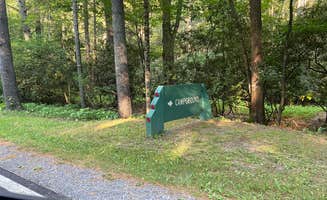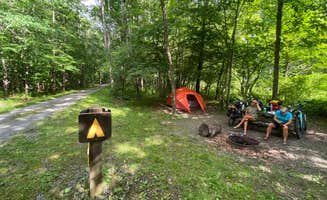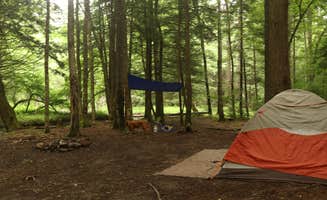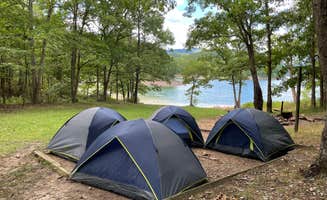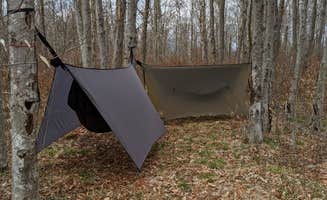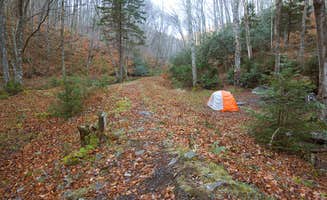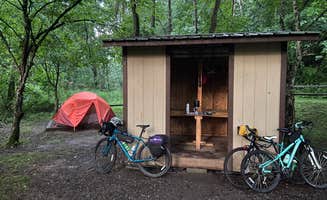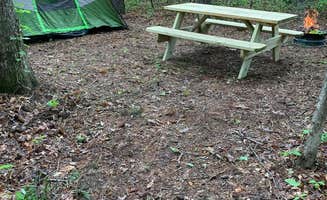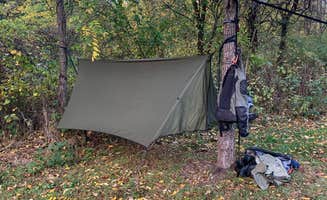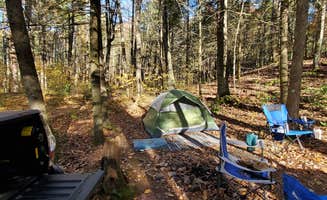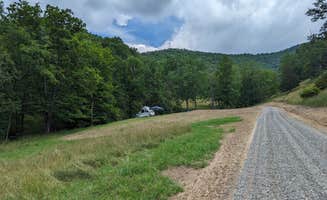Dunmore, West Virginia sits at 2,600 feet elevation in the Allegheny Mountains, surrounded by Monongahela National Forest and Seneca State Forest. The area receives about 55 inches of annual precipitation, creating lush forest conditions that tent campers particularly appreciate during spring and fall when temperatures range from 40-70°F. The region's high elevation brings cool nights even in summer, making it essential to pack extra layers.
What to do
Hiking on East Fork Trail: Access this trail directly from Seven Mile Campground which connects to miles of forest paths. One camper notes that "East Fork trail passes right through the back end of site 10" making it convenient for morning walks.
Wildlife viewing at dawn/dusk: Morning and evening hours at Little River Dispersed Campsites offer excellent animal sightings. A visitor observed that "camping along the Greenbrier River affords great wildlife viewing at dawn and dusk when the animals head to the water to drink" including deer, rabbits, and occasionally bears.
Visit Green Bank Observatory: Located near the Greenbrier River Trail, this facility houses the world's largest steerable radio telescope. A reviewer camping at Greenbrier River Trail MP 63.8 listed it among nearby highlights worth visiting during your stay.
Swimming holes: Several campsites feature natural swimming spots. At Little River, a camper reported, "When you park and walk down to the river, if you turn right, there's a beach area about 50 yards down that offers a great spot to take a dip!"
What campers like
Peaceful seclusion: The campgrounds around Dunmore offer genuine privacy. At Poor Farm Dispersed Recreation Area, one visitor appreciated that it was "Really enjoyed this place... There are maybe 5 ish spots to camp next to a river in this mountain valley" where you can camp without neighbors in sight.
Riverside camping: Sites positioned between water and trail at Greenbrier River Trail MP 63.8 Primitive Campsite feature "a fire pit by the main camping area, and a fire pit down by the creek" creating multiple spaces to enjoy within your site.
Wildlife encounters: The forests around Dunmore teem with animals. One camper at Little River Dispersed Campsites observed "wildlife and songbirds were abundant and as shocked to see you as you were them. Oftentimes, the deer would run the trail ahead of you for 200 yards before cutting off onto their sidetrail."
Reliable facilities: Despite remote locations, many sites maintain clean facilities. At Seven Mile Campground, a visitor found that "each site has a picnic table (nicely shellacked to prevent soggy wood and easily wiped dry), a lantern pole, a fire pit... and a twist-lid garbage can."
What you should know
Bear safety requirements: This is active bear country, requiring proper food storage. A camper at Greenbrier River Trail Milepost 49.3 Primitive Campsite advised "I would recommend utilizing a bear bag or bear canister for your food and toiletries. I used a BearVault BV500 that I strapped to the Salsa EXP Anything Cradle attached to my handlebars."
Weather patterns: Summer brings regular afternoon storms. One visitor to the area observed that "In June, you can anticipate random, short afternoon or evening cloudbursts...but they can be gully-washers. Nights were cool and most mornings I wore a long-sleeve Merino shirt."
Road conditions: Access roads to some sites can be challenging. The route to Little River Dispersed Campsites includes "about 7 miles on a pothole ridden dirt road. Dangerous for RVs, great for those looking for an escape."
No cell service: Most camping areas have no connectivity. A camper at Poor Farm noted, "No cell coverage. Highly recommend for primitive camping" which requires self-sufficiency and advance planning.
Tips for camping with families
Easy access beaches: Look for campsites with gentle water entry points for kids. A visitor to McClintic Point Primitive Campground reported, "There is access to the lake for canoes/kayaks" with sites that "back up to the lake" making water activities simple.
Wildlife education opportunities: The abundant animal sightings create natural learning experiences. At Little River, one visitor spotted "plenty of deer, rabbit, chipmunks and Eastern Box Turtles sharing the trail...but we did see a few turkey, fox and bobcat."
Tent pad selection: Choose raised gravel tent pads for family tents. Seven Mile Campground features "large, raised timbers with a fine pea gravel, leveled and raked. Tent stakes pushed in without much effort but held fast" - ideal for larger family tents.
Avoid holiday weekends: Primitive sites fill quickly during peak periods. One camper noted arriving "around 6pm on a Friday evening" and finding most spots already taken, suggesting mid-week visits for best site selection.
Tips from RVers
Size limitations: Most dispersed sites accommodate smaller vehicles only. At Poor Farm Dispersed Recreation Area, a camper with a conversion van found it "Wasn't too hard to get there and park in our van" though larger RVs would struggle.
Accessibility challenges: Roads to the best tent camping near Dunmore, West Virginia often include narrow, potholed sections. Visitors to Little River warn the access road is "riddled with pot holes and is entirely gravel" requiring careful driving.
Small trailers only: Only small RVs can access most Greenbrier River sites. A camper at Seven Mile noted "a small teardrop camper or popup could be patiently maneuvered onto this site" but warned larger vehicles would need to be "comfortable backing long distances."


